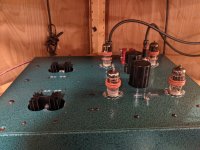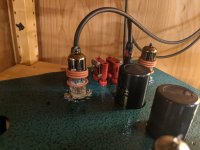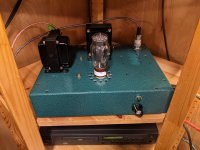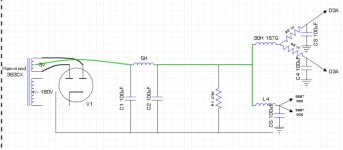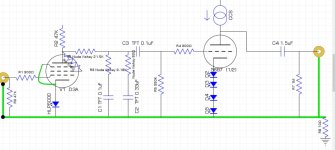You have two nominally identical channels which once worked fine. You therefor have no need to redesign the circuit to cure this new problem, and all components common to both channels are also not at fault. A brute force solution could be found by simply swapping parts between channels - when the problem changes channels, you've found the culprit. A smallish finite number of steps.
Obviously you want the smallest number of steps, so start by "rounding up the usual suspects". You've already swapped valves and such. Soldered-in components are lots more trouble to swap, and LEDs are very difficult to bypass (very low impedance if working) so not always dramatic enough difference to be convincing).
Or, what I'd recommend: There aren't enough parts here to expend a lot of sturm und drang - just shotgun it and sleep easy. Replace a few parts, both channels, at a time, start with the first stage. When cured, declare victory. Life is short.
All good fortune,
Chris
Obviously you want the smallest number of steps, so start by "rounding up the usual suspects". You've already swapped valves and such. Soldered-in components are lots more trouble to swap, and LEDs are very difficult to bypass (very low impedance if working) so not always dramatic enough difference to be convincing).
Or, what I'd recommend: There aren't enough parts here to expend a lot of sturm und drang - just shotgun it and sleep easy. Replace a few parts, both channels, at a time, start with the first stage. When cured, declare victory. Life is short.
All good fortune,
Chris
CCS can work properly, but if the dielectric oxide layer on any mosfet is damaged for example by static electricity noise can occasionally appear. This breakthrough can be easily determined with an ohmmeter. The same thing happened to me once because of careless handling and static electricity.If your CCS is "fried" then you won't have sound on that channel.
The HLMP-6000 is a "standard red" (Gallium Arsenide") LED, which appears to be the quietest chemistry. There have been several measurements posted over the years on various forums, some of them amazingly sophisticated. Being dimmer than more modern designs, there is not a large market for them.
Carbon composition resistors are often mechanically fragile and sensitive to humidity. We (Bottlehead) used them as grid stoppers for a long time, but have replaced them with carbon or metal films in recent years with no known issues.
There are several misconceptions in this (long!) thread, especially around grid resistors and grid stoppers. Just a caution; I don't intend to be a technical editor :^)
Carbon composition resistors are often mechanically fragile and sensitive to humidity. We (Bottlehead) used them as grid stoppers for a long time, but have replaced them with carbon or metal films in recent years with no known issues.
There are several misconceptions in this (long!) thread, especially around grid resistors and grid stoppers. Just a caution; I don't intend to be a technical editor :^)
Thanks everyone for your suggestions. Not only do I have one quiet channel and one that has hiss, I have 3 quiet channels as I have an almost identical phonostage I built a few years ago that is dead silent. The only difference are some different brand resistors (TDK MF instead of another brand) I used in the earlier build. The grid resistors are Rinken CC in BOTH builds. The other major difference is that I mounted panel jacks in parallel with the load resistor so I could adjust the load easily. Swapping those resistors doesn't change things BTW. I did try cleaning the sockets in that channel with ETOH and it MAY be a little quieter.
The unit enclosed except for the valves 'cuz I like the look. Bottom is covered in a perforated aluminum plate. Moving the power supply chassis two additional feet away doesn't help things.
I do not intend to redesign the one but intend to get it on the bench this week.
The unit enclosed except for the valves 'cuz I like the look. Bottom is covered in a perforated aluminum plate. Moving the power supply chassis two additional feet away doesn't help things.
I do not intend to redesign the one but intend to get it on the bench this week.
Attachments
Could you expand on the testing?CCS can work properly, but if the dielectric oxide layer on any mosfet is damaged for example by static electricity noise can occasionally appear. This breakthrough can be easily determined with an ohmmeter. The same thing happened to me once because of careless handling and static electricity.
I will supply the current voltages when I get it on the bench this week But these were my measurements when I built the thing.
Heater voltage 6.29-6.28VDC
B+ 1 208
D3A plates 131 / 136
5687 plates 151 / 151.1
Heater voltage 6.29-6.28VDC
B+ 1 208
D3A plates 131 / 136
5687 plates 151 / 151.1
Attachments
I can suggest something to do before starting to change parts. Open up the bottom, stand it on its side , or prop it up where the air can get underneath it, if you have a quiet fan put it somewhere where it can keep everything well ventilated, and listen to it . See if it starts to hiss. Do that until you are either 100% sure it's thermally triggered or 100% sure it's not related. If it is, then start looking at what gets hot.
Also , one thing I did notice is that the device on the plate load that is heatsunk has pretty long leads. It could well be nothing,( I did see that Ale Bartola's photo shows it done the same way) but I think it's worth making a note of in case you don't find the source of the noise anywhere else.
Good luck !
Also , one thing I did notice is that the device on the plate load that is heatsunk has pretty long leads. It could well be nothing,( I did see that Ale Bartola's photo shows it done the same way) but I think it's worth making a note of in case you don't find the source of the noise anywhere else.
Good luck !
Revisiting this. For some reason the problem all but disappeared for almost a year. Noisy channel was slightly more "hissy" than the other but not intrusively so - so I patiently waited for the noise to become more prominent. Well, in the last few days things became noisy again. I did try placing a fan blowing into the unit with no change. The noise really appears within a minute of powering the unit up. Once again, the same conditions as mentioned in the first post still hold true. Swapping tubes does not change things. Shorting the inputs does not change things.
I tried cooling the inside with a fan but that did not alter the noise. Currently, it seems that the noise appears almost as soon as the unit powered up with a little increase in volume as the hours pass. Currently, I'd have to say it resembles tube "rush" (a rustling) rather than a perfectly smooth hiss. Will start into some of the troubleshooting recommendations in the next few days.


I tried cooling the inside with a fan but that did not alter the noise. Currently, it seems that the noise appears almost as soon as the unit powered up with a little increase in volume as the hours pass. Currently, I'd have to say it resembles tube "rush" (a rustling) rather than a perfectly smooth hiss. Will start into some of the troubleshooting recommendations in the next few days.
Last edited:
Divide and conquer.
Ground the second grid, and see if the noise is gone. Then if the noise is gone, the problem is before the second stage.
Ground the second grid, and see if the noise is gone. Then if the noise is gone, the problem is before the second stage.
Last edited:
The problem, I suspect, with grounding out the second stage is the gain, and therefore, the noise drops as well. But I am going to try that.
The problem, I suspect, with grounding out the second stage is the gain, and therefore, the noise drops as well. But I am going to try that.
Mostly to test the unknown CCS. It should be pretty obvious whether the abnormal noise is still there or not.
Gain of the second stage won't change, and if the noise is in the second stage, the noise will remain exactly the same.
just replace the CCS with a resistor that causes the same voltage drop and see what happens to the noise.
- Home
- Amplifiers
- Tubes / Valves
- Phono-Stage Hiss
